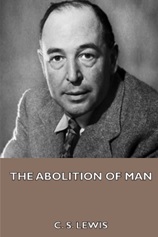
This is a short, transcendent work that can be purchased
at a very low price HERE.
Publisher: ValdeBooks (November 9, 2023)
Language: English
Paperback: 59 pages
ISBN-13: 978-1444421347
"The Abolition of Man" is a philosophical work written in 1943 by Clives Staples Lewis, best known as the author of "The Chronicles of Narnia", among 30 other books under the nom de plume C.S. Lewis.
In this book, Lewis critiques the idea of moral subjectivism and the consequences of a society that denies objective values. He argues that the rejection of universal moral principles and the elevation of personal preferences will lead to the destruction of human nature and the loss of a common moral framework.
Lewis begins by discussing the implications of a textbook titled "The Green Book," which promotes relativism and denies the existence of objective values. He warns that such an approach will result in the elimination of human virtues and the reduction of humanity to mere objects manipulated by those in power. He emphasizes the importance of the "Tao," a term he uses to describe the universal moral law that transcends cultures and religions. Lewis argues that without this shared moral foundation, society becomes susceptible to manipulation and tyranny. "The Abolition of Man" is a thought-provoking critique of relativism and an appeal for the preservation of objective moral values. It challenges readers to recognize the dangers of subjectivism and to embrace a universal moral framework that fosters the development of true human virtues.
In this book, Lewis refers to a war metaphor and argues that: “In battle it is not syllogisms that will keep the reluctant nerves and muscles to their post in the third hour of the bombardment. The crudest sentimentalism … about a flag or a country or a regiment will be of more use.” The idea—here, of loyalty—is meaningless and cannot move us to action unless it captures the imagination through a tangible sign.
But imagination is shaped through the most subtle of movements. A deft stroke here, an obscure tale there—a nudge, a smile—thus a soul is shaped, a soul that either welcomes with joy the fullness of reality (material and spiritual) or shies away from it. That, Lewis reminds us, is what being alive is all about: it is our chance to learn to exist in a happy, correct relation to reality. The physical world is an array of signs, indicating how we are to live.
Comments powered by CComment